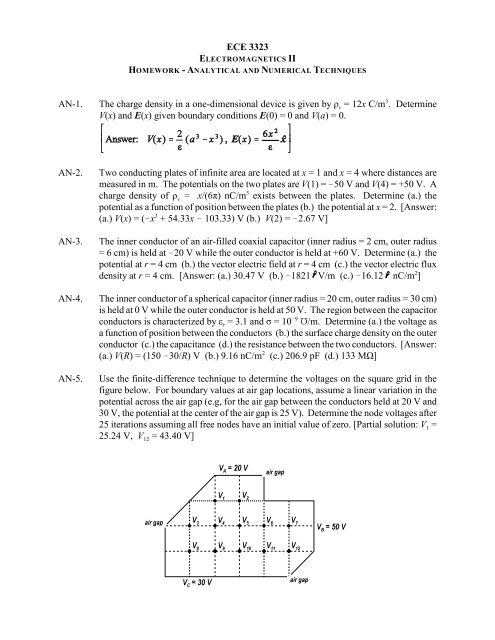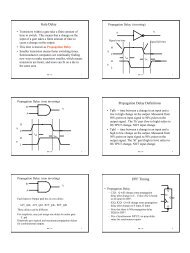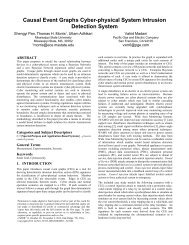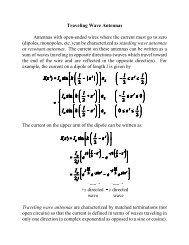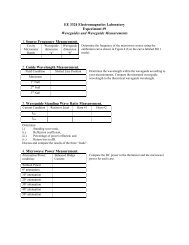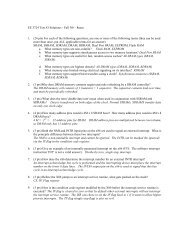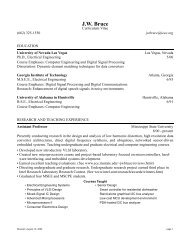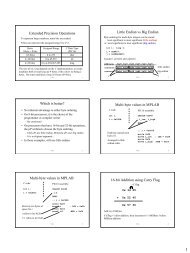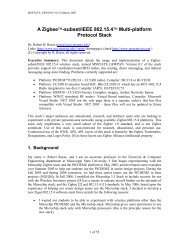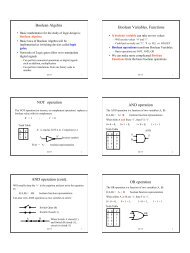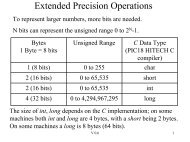ECE 3323 AN-1. The charge density in a one-dimensional device is ...
ECE 3323 AN-1. The charge density in a one-dimensional device is ...
ECE 3323 AN-1. The charge density in a one-dimensional device is ...
You also want an ePaper? Increase the reach of your titles
YUMPU automatically turns print PDFs into web optimized ePapers that Google loves.
<strong>ECE</strong> <strong>3323</strong>ELECTROMAGNETICS IIHOMEWORK - <strong>AN</strong>ALYTICAL <strong>AN</strong>D NUMERICAL TECHNIQUES<strong>AN</strong>-<strong>1.</strong>3<strong>The</strong> <strong>charge</strong> <strong>density</strong> <strong>in</strong> a <strong>one</strong>-<strong>dimensional</strong> <strong>device</strong> <strong>is</strong> given by ñ v = 12x C/m . Determ<strong>in</strong>eV(x) and E(x) given boundary conditions E(0) = 0 and V(a) = 0.<strong>AN</strong>-2.<strong>AN</strong>-3.<strong>AN</strong>-4.<strong>AN</strong>-5.Two conduct<strong>in</strong>g plates of <strong>in</strong>f<strong>in</strong>ite area are located at x = 1 and x = 4 where d<strong>is</strong>tances aremeasured <strong>in</strong> m. <strong>The</strong> potentials on the two plates are V(1) = 50 V and V(4) = +50 V. A3<strong>charge</strong> <strong>density</strong> of ñ v = x/(6ð) nC/m ex<strong>is</strong>ts between the plates. Determ<strong>in</strong>e (a.) thepotential as a function of position between the plates (b.) the potential at x = 2. [Answer:3(a.) V(x) = (x + 54.33x 103.33) V (b.) V(2) = 2.67 V]<strong>The</strong> <strong>in</strong>ner conductor of an air-filled coaxial capacitor (<strong>in</strong>ner radius = 2 cm, outer radius= 6 cm) <strong>is</strong> held at 20 V while the outer conductor <strong>is</strong> held at +60 V. Determ<strong>in</strong>e (a.) thepotential at r = 4 cm (b.) the vector electric field at r = 4 cm (c.) the vector electric flux<strong>density</strong> at r = 4 cm. [Answer: (a.) 30.47 V (b.) 1821 V/m (c.) 16.12 nC/m 2 ]<strong>The</strong> <strong>in</strong>ner conductor of a spherical capacitor (<strong>in</strong>ner radius = 20 cm, outer radius = 30 cm)<strong>is</strong> held at 0 V while the outer conductor <strong>is</strong> held at 50 V. <strong>The</strong> region between the capacitor9conductors <strong>is</strong> characterized by å r = 3.1 and ó = 10 /m. Determ<strong>in</strong>e (a.) the voltage asa function of position between the conductors (b.) the surface <strong>charge</strong> <strong>density</strong> on the outerconductor (c.) the capacitance (d.) the res<strong>is</strong>tance between the two conductors. [Answer:2(a.) V(R) = (150 30/R) V (b.) 9.16 nC/m (c.) 206.9 pF (d.) 133 MÙ]Use the f<strong>in</strong>ite-difference technique to determ<strong>in</strong>e the voltages on the square grid <strong>in</strong> thefigure below. For boundary values at air gap locations, assume a l<strong>in</strong>ear variation <strong>in</strong> thepotential across the air gap (e.g, for the air gap between the conductors held at 20 V and30 V, the potential at the center of the air gap <strong>is</strong> 25 V). Determ<strong>in</strong>e the node voltages after25 iterations assum<strong>in</strong>g all free nodes have an <strong>in</strong>itial value of zero. [Partial solution: V 1 =25.24 V, V = 43.40 V]12
<strong>AN</strong>-6.Given the <strong>one</strong>-<strong>dimensional</strong> Po<strong>is</strong>son’s equationwith = 60 o and subject to boundary conditions of V(0) = 0V and V(1) = 5V, use thef<strong>in</strong>ite-difference technique to solve for the potential with Äx = 0.2. Assume the <strong>in</strong>itialguess (zeroth iteration) for all free node voltages <strong>is</strong> the average of the two boundary(n)values. (a.) Determ<strong>in</strong>e the difference equation for V i where i <strong>is</strong> the grid po<strong>in</strong>t <strong>in</strong>dex andn <strong>is</strong> the iteration number. (b.) Determ<strong>in</strong>e the free node voltages for the second iteration.(n) (n-1) (n-1) (2)[Answer: (a.) V = 0.5 {V + V +2.4} V (b.) V = 3.05 V]i i-1 i+1 1<strong>AN</strong>-7.Use the method of moments to determ<strong>in</strong>e the <strong>charge</strong> <strong>density</strong> along a the length of a th<strong>in</strong>flat conduct<strong>in</strong>g strip (1 cm × 41 cm) <strong>in</strong> air held at a potential of 1 V. Subdivide the strip<strong>in</strong>to 41 (1cm×1cm) patches of uniform <strong>charge</strong> <strong>density</strong>. [Partial answer: surface <strong>charge</strong>2<strong>density</strong> at the end of the strip = <strong>1.</strong>76 nC/m , surface <strong>charge</strong> <strong>density</strong> at the middle of thestrip = <strong>1.</strong>02 nC/m 2 ]


